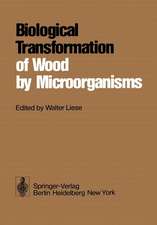Agarwood: Science Behind the Fragrance: Tropical Forestry
Editat de Rozi Mohameden Limba Engleză Hardback – 9 iun 2016
| Toate formatele și edițiile | Preț | Express |
|---|---|---|
| Paperback (1) | 925.66 lei 39-44 zile | |
| Springer Nature Singapore – 7 iun 2018 | 925.66 lei 39-44 zile | |
| Hardback (1) | 942.15 lei 39-44 zile | |
| Springer Nature Singapore – 9 iun 2016 | 942.15 lei 39-44 zile |
Preț: 942.15 lei
Preț vechi: 1239.68 lei
-24% Nou
Puncte Express: 1413
Preț estimativ în valută:
180.28€ • 187.86$ • 149.27£
180.28€ • 187.86$ • 149.27£
Carte tipărită la comandă
Livrare economică 31 martie-05 aprilie
Preluare comenzi: 021 569.72.76
Specificații
ISBN-13: 9789811008320
ISBN-10: 9811008329
Pagini: 180
Ilustrații: X, 167 p. 48 illus., 38 illus. in color.
Dimensiuni: 155 x 235 x 15 mm
Greutate: 0.53 kg
Ediția:1st ed. 2016
Editura: Springer Nature Singapore
Colecția Springer
Seria Tropical Forestry
Locul publicării:Singapore, Singapore
ISBN-10: 9811008329
Pagini: 180
Ilustrații: X, 167 p. 48 illus., 38 illus. in color.
Dimensiuni: 155 x 235 x 15 mm
Greutate: 0.53 kg
Ediția:1st ed. 2016
Editura: Springer Nature Singapore
Colecția Springer
Seria Tropical Forestry
Locul publicării:Singapore, Singapore
Cuprins
The Origin and Domestication of Aquilaria, an Important Agarwood-Producing Genus.- Wood Resources, Identification and Utilization of Agarwood in China.- Understanding Agarwood Formation and Its Challenges.- Development of Agarwood Induction Technology Using Endophytic Fungi.- Molecular Mechanism Studies of Terpenoid Biosynthesis in Agarwood.- Gyrinops walla: The Recently Discovered Agarwood Producing Species in Sri Lanka.- Resolution of Complex Sesquiterpene Hydrocarbons in Aquilaria malaccensis Volatile Oils Using Gas Chromatography Technique.- Pharmacological Effects of Aquilaria spp. Leaves and Their Chemical Constituents.- Acoustic-Based Technology for Agarwood Detection in Aquilaria Trees.- Keeping Up Appearances – Agarwood Grades and Quality.
Recenzii
“The book highlights information regarding ‘agarwood’ – fragrant natural product from trees of the Thymelaeaceae family, belonging to Aquilaria and related species. … this book can be considered as the first step to overcoming the lack of knowledge on Aquilaria and related agarwood species. The editor has brought to focus the incomprehension on agarwood species.” (S. Suresh Ramanan and Anatoliy A. Khapugin, Current Science, Vol. 113 (8), October, 2017)
Notă biografică
Rozi Mohamed is Associate Professor at the Faculty of Forestry, Universiti Putra Malaysia. She received her trainings from the Oregon State University, USA, in the fields of forest biotechnology and plant pathology.
Her research on Agarwood started in 2006. Agarwood is a non-wood product from the endangered Aquilaria and Gyrinops trees, highly prized for its use in fragrances and medicines. Her research projects were designed to answer questions such as identifying the triggers behind Agarwood formation. She applies molecular, genomics and tissue culture approaches to study the mechanism of Agarwood synthesis in Aquilaria. Special attention is given to the role of diverse fungi and bacteria, which is known to be useful pathogens for Agarwood inducement.
Being a forester and an ecologist herself, Rozi is especially interested in developing new methods for rapid detection of Aquilaria as a means to circumvent illegal Agarwood trade. Her work on Agarwood hasbeen recognized globally, as evident from the invitations she received to review manuscripts on Agarwood by various international journals. Recently, she organized the 1st International Scientific Symposium on Agarwood (ISSA 2013) at UPM, which received vast responses from the international Agarwood community, scientists and traders alike. Following this success, she will organize its sequel, the highly anticipated 2nd ISSA in 2016.
Textul de pe ultima copertă
This book gives readers new information to understand the mechanism of agarwood induction and therefore eradicate the myths surrounding agarwood formation. One of the challenges in conserving agarwood resources is species identification. In this book, taxonomy and systematics of agarwood-producing trees from historical and recent perspectives is discussed, and tips are given for identifying cultivated species. In addition, color illustrations are given to highlight vegetative and reproductive characteristics as well as anatomical features, for identification purposes of both plant and agarwood sources. Another challenge that planters are facing is in acquiring the correct method for agarwood induction, thus development of agarwood induction technologies will be reviewed. A chapter dedicated to bioinduction is included. The book will comprise a chapter on the use of non-destructive technology as a management tool for cultivating agarwood. The book also discusses issues relating to agarwood grades. The absence of an international standard that is acceptable by producer and consumer countries further complicates the issue. Other useful information includes a systematic revelation of agarwood constituents and their complex chemistry, and highlights on a specific pharmaceutical property.
Caracteristici
Provides readers with a reliable source on the subject of agarwood and its producing tree species Includes a review on agarwood induction techniques and presents readers with new methods A special chapter on agarwood grades helps readers to understand the different grading practices in sourcing countries
























